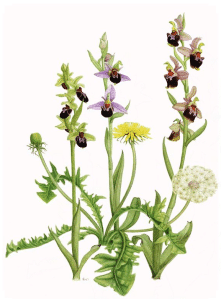Fantastic piece on metaphor in Aeon – See through words

“If you could ask Dante where he got the idea of life as a road, or Rilke where he found the notion that time is a destroyer, they might have said the metaphors were hewn from their minds, or drawn from a stock of poetic imagery. Their readers might have said the imagery had origins more divine, perhaps even diabolical. But neither poets nor readers would have said the metaphors were designed. That is, the metaphors didn’t target people’s cognitive processes. They weren’t engineered to affect us in a specific way.”
If you’re at all interested in metaphor and language, the entire Aeon piece is a must read – as are the comments which add some intelligent critical debate (in online comments… I know!).
Dandelions and orchids

But there was one idea that stood out – the potential danger of using metaphor in a one-size-fits all approach:
“…you do have to be careful with emotional responses. I worked on a project about childhood resilience. The question was how do children turn out well despite difficult circumstances? We had become acquainted with the metaphor of dandelions and orchids, which originated with the paediatrician Tom Boyce at Berkeley. He used it to describe two types of child, one who did well in a range of circumstances (the dandelion), and one who succeeded only under a narrow set of circumstances (the orchid). Journalists liked it – the US science writer David Dobbs was writing a book under this title. It was thought to be conventionally successful. But it had never been tested with users.
We found that people knew what orchids and dandelions were (not always something you can count on). Also, the comparison appeared to help them understand why certain children do well and others don’t. Yet there was a problem: people valued the orchid and looked down on the dandelion. The culture said they should value the rare, beautiful thing, not the sturdy weed. And so the average American saw no sense in making more dandelions. Besides, their child was not common but special and rare.
…In the end, we developed the metaphor of a weighing scale to explain how positive influences can outweigh negative ones in a child’s early life, thereby making resilience not a trait of the individual person but a function of that person’s environment.” (emphasis added)
In Lakoff and Johnson’s highly influential book Metaphors We Live By they propose that metaphors refer to the understanding of one concept, or conceptual domain, in terms of another. They identified multiple conceptual metaphors including LOVE IS A JOURNEY, LOVE IS WAR, and LIFE IS A JOURNEY (I’ve followed their convention of using capitalisation to denote a conceptual metaphor). Based on Lakoff and Johnson’s idea, the conceptual metaphor for the example quoted above would be something like CHILDREN ARE FLOWERS or CHILDREN ARE PLANTS. The danger of this conceptual mapping is obvious, as the article discusses – not all plants are wanted, some plants are ‘beautiful’ while others are ‘weeds’, but also, plants can die easily, plants can be pulled out, trampled on, poisoned, consumed, and so on.
Back to the Aeon piece:
“…it’s not hard to think of metaphors that over-simplify an aspect of the world, or that obscure reality. Is a bank really a container that we put our money in? Is a child a flower? These are conventional metaphors, but if you soup them up, you can make them into something dangerous. They take something that’s already strongly expressed in the culture, something that reinforces the existing framing of an issue, and makes it even more cognitively usable. Is running a national economy really like balancing a household budget? In the US, people believe that the family is the most salient social unit, which makes the ‘national budget is a household budget’ exceedingly sticky and powerful. That’s why politicians of a reactionary stripe find it useful to keep these misunderstandings around.” (emphasis added)
Metaphors can be sticky, trendy, catchy and easy – too easy, but also misleading, over-simplified and deleterious to deep understanding. Lakoff and Johnson’s notion of one-to-one conceptual mapping might need to be considered carefully – saying one thing is the same as another -LOVE IS A JOURNEY- can help explain some common linguistic expressions, but it can also constrain understanding and iron out the wrinkles, obliterating the interesting nuances of human experience. Is love just the process of getting from one place to another?
Construct and use metaphors with care, and perhaps be wary of metaphors that become slogans or memes.
-Tim Cocks
Related ‘jams
A selection of more noijam blogs on metaphor and language
Read Explain Pain and Explain Pain Supercharged for an in-depth look into metaphor and pain

How metaphors can activate (such as the limbic system) brain areas and ultimatly but not exclusivly can change behavior:
“This Is Your Brain on Metaphors”
by Robert Sapolsky
Quote: “Consider an animal (including a human) that has started eating some rotten, fetid, disgusting food. As a result, neurons in an area of the brain called the insula will activate. Gustatory disgust. Smell the same awful food, and the insula activates as well. Think about what might count as a disgusting food (say, taking a bite out of a struggling cockroach). Same thing.
Now read in the newspaper about a saintly old widow who had her home foreclosed by a sleazy mortgage company, her medical insurance canceled on flimsy grounds, and got a lousy, exploitative offer at the pawn shop where she tried to hock her kidney dialysis machine. You sit there thinking, those bastards, those people are scum, they’re worse than maggots, they make me want to puke… and your insula activates. Think about something shameful and rotten that you once did… same thing. Not only does the insula “do” sensory disgust; it does moral disgust as well. Because the two are so viscerally similar. When we evolved the capacity to be disgusted by moral failures, we didn’t evolve a new brain region to handle it. Instead, the insula expanded its portfolio. ”
http://nationalhumanitiescenter.org/on-the-human/2010/11/your-brain-on-metaphors/